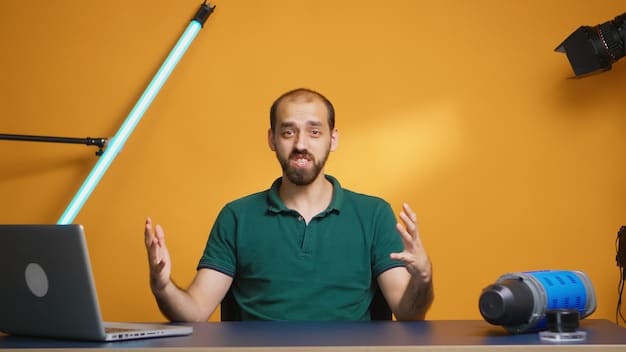Master Public Speaking in the Digital Age: Online & Offline Engagement

Mastering public speaking in the digital age demands a dual approach, balancing traditional oratorical skills with a nuanced understanding of online platforms to captivate and influence diverse audiences effectively, transcending geographical and technological barriers.
In an increasingly interconnected world, the ability to communicate effectively remains paramount. While traditional public speaking still holds immense value, the rise of digital platforms has fundamentally reshaped how we engage with audiences. This article explores the evolving landscape of Public Speaking in the Digital Age: Engaging Audiences Online and Offline, offering insights and strategies for impactful communication.
The Evolution of Public Speaking: Adapting to New Realities
The foundational principles of public speaking, such as clarity, conviction, and connection, endure. However, the channels through which these principles are applied have diversified dramatically. From grand auditoriums to intimate webcams, the stage has expanded, demanding a more adaptable and versatile speaker. Understanding this evolution is the first step towards mastering communication in the 21st century.
Traditional Oratory Meets Digital Demands
Public speaking historically conjured images of podiums and large crowds. Today, these scenarios coexist with virtual meetings, webinars, podcasts, and livestreams. The essence remains the same—to convey a message effectively—but the tools and techniques have multiplied. Speakers now navigate not just stage presence but also screen presence, often simultaneously. This blend requires a sophisticated skill set that encompasses both established rhetoric and emergent digital literacy. The transition is not simply about adopting new technology, but rather about leveraging it to enhance connection.
- Audience Fragmentation: Digital platforms allow for hyper-targeted audiences, sometimes niche and sometimes global, requiring tailored content.
- Interactive Expectations: Online audiences often expect direct engagement through chats, polls, and Q&A sessions, shifting from passive listening.
- Visual Storytelling: High-quality visuals, graphics, and multimedia are even more critical online to maintain attention in a distraction-prone environment.
- Technological Fluency: Proficiency with platforms, microphones, cameras, and lighting is now a prerequisite for professional delivery.
The digital realm introduces nuances like latency, variable internet speeds, and the absence of immediate physical feedback, which speakers must learn to anticipate and manage. Successful speakers understand that an engaging presentation online is not merely a recorded version of an in-person speech; it is a distinct art form with its own set of rules and opportunities for innovation. Integrating both worlds effectively demands a strategic approach to content, delivery, and interaction.
Ultimately, whether offline or online, the goal is to resonate with the audience. The digital age provides unprecedented opportunities to reach across geographical boundaries and engage with a global community. This expansive reach, however, comes with the responsibility to maintain authenticity and impact, regardless of the medium. The blend of traditional gravitas with digital agility is the hallmark of a modern public speaker.
Crafting Compelling Content Across Platforms
The adage “content is king” holds true, perhaps even more so, in the digital age. Audiences online have shorter attention spans and an abundance of choices, demanding content that is not only informative but also highly engaging and easily digestible. Offline, the expectation for well-researched, thought-provoking material remains constant.
Designing for Dual Engagement
Developing content for both online and offline delivery requires a strategic mindset. While the core message might be consistent, its presentation needs to be adapted. Online, brevity and visual appeal are paramount. Think in terms of digestible chunks, strong headlines, and multimedia integration. Offline, there’s more room for extended narratives, detailed examples, and spontaneous audience interaction. Speakers must master the art of contextualizing their message for each format, ensuring relevance and impact. This dual-pronged approach allows the speaker to maximize reach without diluting the message.
- Modular Content: Create content that can be easily broken down into smaller segments for social media or expanded for a live presentation.
- Visual Aids: Prioritize high-quality, impactful visuals that translate well to both large screens and small device displays.
- Strong Call to Action: Clearly define what you want your audience to do, whether it’s subscribing, visiting a website, or asking a question offline.
- Storytelling: Incorporate compelling stories that resonate emotionally and logically, regardless of the medium.
Consider the fundamental difference in audience attention. Online, multitasking is common, and distractions are abundant. Therefore, content must immediately capture attention and sustain it through dynamic delivery and purposeful engagement. Offline, while distractions can still occur, the focused environment of a live event often allows for deeper dives into complex topics. The smart speaker knows how to leverage these environmental differences to their advantage, ensuring that their message is not just heard, but truly absorbed.
The goal is to create a dynamic content portfolio that is robust enough for a keynote address and nimble enough for a quick social media update. By focusing on intrinsic value and adapting its delivery, speakers can ensure their message cuts through the noise. This adaptability ensures that the speaker’s expertise and authority are consistently conveyed, irrespective of the platform.
Mastering Online Presence: Tools and Techniques for Virtual Success
Excelling in virtual public speaking goes beyond simply showing up in front of a camera. It involves understanding the unique demands of digital platforms and leveraging specific tools and techniques to create an immersive and impactful experience for the audience. A strong online presence is now a critical component of a speaker’s repertoire.

Optimizing Your Virtual Stage
Your digital “stage” encompasses everything from your chosen platform (Zoom, Google Meet, Microsoft Teams, etc.) to your physical environment. Professional lighting, clear audio, and a clean, uncluttered background are non-negotiable. Furthermore, speakers must learn to interact with the camera as if it were a person, maintaining eye contact and conveying warmth and sincerity. Technical competence is as important as oratorical skill in this domain, as glitches can severely detract from the message. Rehearsal not only of content but also of technical transitions is key to a seamless delivery.
- High-Quality Audio: Invest in an external microphone for clear sound; poor audio is often the biggest detractor in virtual presentations.
- Effective Lighting: Natural light is best, or an artificial light source directly facing you to eliminate shadows.
- Engaging Visuals: Utilize presentation software effectively, with clean slides, animated elements, and minimal text to keep the audience focused.
- Platform Familiarity: Understand the features of your chosen platform, including screen sharing, polls, breakouts, and chat functions, to maximize interaction.
Beyond the technical aspects, mastering online presence involves a different kind of energy. Since physical gestures and movement are limited, facial expressions, vocal inflection, and deliberate pauses become even more critical in conveying emotion and emphasis. Moreover, the dynamic of Q&A sessions differs; often, questions come in via chat, requiring the speaker to multitask or rely on a moderator. Practicing these scenarios helps build confidence and ensures a smooth, professional delivery. The goal is to make the virtual experience feel as personal and engaging as possible, bridging the digital divide with authentic connection.
Ultimately, a strong virtual presence is built on preparation and an understanding of the medium’s unique advantages and limitations. By embracing these nuances, speakers can transform a potentially sterile online interaction into a vibrant, impactful engagement. The future of public speaking relies heavily on this digital dexterity.
Connecting with Offline Audiences: Reinvigorating Traditional Skills
While virtual platforms offer boundless reach, the power of in-person connection remains unparalleled. Engaging an offline audience leverages the full spectrum of human interaction, from body language and vocal dynamics to shared physical space. The art of captivating a live audience continues to be a cornerstone of effective public speaking.
Enhancing In-Person Engagement
In an offline setting, your entire physical presence becomes part of your message. Confident posture, purposeful movement, and expressive gestures amplify your words. The immediate feedback loop—seeing nods, smiles, or confused looks—allows for real-time adaptation of your delivery. Speakers should embrace the stage, using it to create a dynamic and memorable experience. Harnessing the energy of the room and fostering a sense of shared experience are central to powerful in-person engagement. This is where subtle non-verbal cues profoundly impact message reception.
- Body Language Mastery: Use open gestures, maintain strong eye contact with various audience members, and move purposefully to command attention.
- Vocal Variety: Modulate your tone, pace, and volume to emphasize points, build suspense, and maintain audience interest.
- Stage Presence: Occupy the space with confidence, making it your own, and using it to reinforce your narrative.
- Interactive Elements: Incorporate live Q&A, group activities, or direct audience participation to foster a dynamic environment.
The unique advantage of in-person speaking is the ability to build rapport through direct interaction. A well-placed anecdote, a moment of shared laughter, or an empathetic response to a question can forge deep connections. Unlike the online environment, where distractions are often personal to the viewer, in a physical room, the distractions are often shared, allowing the speaker to address them collectively or to use them to their advantage. Moreover, the energy exchange between speaker and audience is palpable, creating a synergistic effect that elevates the entire experience.
Ultimately, the goal is to create an experience that feels personal, impactful, and authentic. By honing these traditional skills, speakers ensure that their message lands with conviction and leaves a lasting impression. The enduring power of human connection, amplified through skilled oratory, remains irreplaceable.
Bridging the Gap: Hybrid Speaking Strategies
The reality for many modern communicators is a blend of both worlds: hybrid events that seamlessly integrate online and offline audiences. This presents a unique challenge, requiring speakers to engage two distinct groups simultaneously, ensuring neither feels secondary. Mastering hybrid formats is becoming an essential future skill.
Seamless Integration for Dual Impact
A successful hybrid presentation demands a strategy that caters to both physical and virtual attendees. This means not only optimizing your setup for both environments but also actively engaging both groups throughout your talk. Imagine having a “virtual co-host” who manages online questions and polls, while you focus on the in-person audience and intermittently address the virtual one. The key is to design interactions that feel inclusive, making everyone feel like a valued part of the conversation, regardless of their location. This often involves careful planning and smart use of technology.
- Dedicated Moderation: Assign a moderator specifically for online engagement, feeding questions and comments to the speaker.
- Integrated Q&A: Designate specific times for questions, inviting contributions from both in-person and online attendees.
- Visual Hybridity: Ensure slides and visuals are clear for both large screens and smaller devices, with text large enough to read from afar and up close.
- Technology Check: Perform thorough sound and visual checks for both the event space and the streaming platform to prevent technical disruptions.
One common pitfall in hybrid events is focusing too heavily on one audience over the other. The speaker must consciously alternate their attention, making eye contact with the camera for virtual attendees and with individuals in the room for physical attendees. This creates a sense of presence for everyone. Also, consider interactive elements that can be performed by both groups, such as polls that can be answered via a show of hands offline and through a voting tool online. The art of bridging this gap lies in thoughtful design and fluid execution, transforming a potential compromise into a powerful expansion of reach.
Ultimately, hybrid speaking is not simply about being available in two places at once; it’s about crafting an experience that maximizes impact for everyone involved. By adopting these strategies, speakers can deliver compelling presentations that resonate deeply with diverse, geographically dispersed audiences. This integration defines the frontier of modern public speaking.
Practice, Feedback, and Continuous Improvement
Excellence in public speaking, digital or traditional, is rarely accidental. It is the result of deliberate practice, receptive feedback, and a commitment to continuous improvement. Mastering the art of communication is an ongoing journey that evolves with every presentation and every interaction.
The Iterative Path to Mastery
Regular practice is the bedrock of powerful public speaking. This goes beyond rehearsing your lines; it involves practicing delivery, timing, and audience engagement, both for online and offline contexts. Recording yourself and critically reviewing your performance can reveal areas for improvement that might otherwise go unnoticed. Seeking constructive feedback from peers, mentors, or even dedicated coaches provides invaluable external perspectives. This iterative process of preparation, delivery, self-assessment, and external review is what transforms a good speaker into a truly great one. Embracing vulnerability and viewing every presentation as a learning opportunity accelerates growth.
- Record and Review: Film your practice sessions and critically analyze your body language, vocal patterns, and interaction style.
- Seek Diverse Feedback: Ask for specific, actionable feedback from a variety of sources, including those familiar with both online and offline speaking.
- Micro-Practice: Practice small segments of your speech or isolated skills, such as handling Q&A or using visual aids effectively.
- Reflect and Adapt: After each presentation, take time to reflect on what went well and what could be improved, adjusting your approach for future engagements.
The digital age offers new avenues for both practice and feedback. Online platforms allow for easy recording and sharing of presentations, making self-assessment and peer review more accessible. Virtual coaching sessions can provide personalized guidance, helping speakers refine their screen presence and technical delivery. Furthermore, observing other successful digital communicators can offer inspiration and practical strategies. The key is to remain curious and open to new approaches, recognizing that the landscape of public speaking is constantly evolving.
Ultimately, the journey of becoming an exceptional public speaker is one of relentless refinement. By committing to practice, actively soliciting feedback, and continuously striving for improvement, speakers can cultivate a powerful, authentic, and impactful voice that resonates across all platforms. This dedication ensures relevance and influence in any speaking environment.
The Future of Engaging Audiences: AI and Beyond
As technology continues its rapid advancement, the future of public speaking promises even more sophisticated tools and dynamic engagement opportunities. Artificial intelligence, virtual reality, and augmented reality are already beginning to shape how speakers prepare, deliver, and connect with their audiences. Embracing these innovations will be key to staying relevant.
Innovations Redefining the Speaking Landscape
AI-powered tools are emerging to assist speakers in various ways, from refining speech delivery to analyzing audience sentiment. These tools can offer real-time feedback on pacing, tone, and filler words, essentially providing a virtual coach. Virtual and augmented reality present possibilities for immersive presentations that transcend traditional boundaries, allowing for interactive experiences that blur the lines between physical and digital spaces. Speakers who embrace these advancements will not only enhance their performance but also create unique, memorable experiences for their audiences. Understanding the potential of these technologies will differentiate the forward-thinking communicator. The integration of advanced analytics can also provide insights into audience engagement unseen before.
- AI-Powered Coaching: Utilize applications that analyze your speech patterns, provide feedback on vocal clarity, and suggest improvements in delivery.
- Immersive Environments: Explore VR/AR platforms for delivering presentations in virtual auditoriums or creating interactive 3D content.
- Personalized Content Delivery: Leverage data analytics to tailor messages and examples to specific audience segments in real-time.
- Holographic Presentations: Anticipate advancements that could enable hyper-realistic holographic projections for distant appearances.
The integration of these technologies also raises new ethical considerations regarding authenticity and human connection. While AI can enhance performance, the speaker’s true voice and genuine interaction remain paramount. The challenge will be to leverage technology as an amplifier of human communication, rather than a replacement for it. The future speaker will be a skilled orator, a tech-savvy innovator, and a thoughtful curator of meaningful experiences. These tools are designed to augment, not diminish, the human element of public speaking, ensuring that the core message retains its emotional integrity and impact.
Ultimately, the future of engaging audiences will be shaped by a harmonious blend of human artistry and technological innovation. By staying abreast of these developments and thoughtfully integrating them into their practice, speakers can continue to captivate and inspire, no matter how the landscape evolves. The human connection, facilitated by cutting-edge tools, will define the next generation of powerful communication.
| Key Aspect | Brief Description |
|---|---|
| 🌐 Digital Adaptability | Seamlessly transition skills from in-person to virtual stages, mastering screen presence. |
| 💡 Content Customization | Tailor messages for different platforms, prioritizing visuals for online and depth for offline. |
| 🤝 Hybrid Engagement | Strategies for simultaneously captivating both virtual and physical audiences in blended events. |
| 📈 Continuous Growth | Embrace feedback, record practices, and adapt to emerging technologies like AI for improvement. |
Frequently Asked Questions About Public Speaking in the Digital Age
Digital technology has expanded the stage for public speaking, allowing for global reach but introducing new challenges like maintaining audience engagement online. It requires speakers to master elements like virtual presence, clear audio-visuals, and interactive online tools, complementing traditional rhetorical skills with technological fluency. The focus shifted to adapting content and delivery for diverse digital environments.
Key technical considerations include reliable internet, high-quality audio (an external microphone is crucial), good lighting (preferably natural or front-facing), a clean and professional background, and familiarity with the chosen platform’s features. Technical glitches can severely undermine a strong message, so thorough preparation and testing are vital for a seamless delivery.
Engaging a hybrid audience requires a balanced approach. Speak to both the camera and the room, using a dedicated online moderator for virtual questions and comments. Integrate interactive elements like polls that both groups can participate in, and design visuals that are clear whether viewed on a large screen or a small device. Acknowledge both audiences periodically to ensure inclusivity.
Storytelling remains a critical component in modern public speaking, regardless of the platform. Compelling narratives help connect with audiences emotionally, making messages more memorable and relatable. In the digital age, concise and impactful stories are particularly effective in capturing and sustaining attention amidst distractions, whether delivered in a live presentation or a brief online video.
AI tools can help speakers by providing real-time feedback on vocal tone, pacing, filler words, and even body language through video analysis. They can also assist in generating ideas, structuring speeches, and identifying areas for improvement, effectively acting as an automated coach. While AI enhances technical aspects, the human element of connection and authenticity remains paramount.
Conclusion
Connecting effectively with audiences, whether in a crowded auditorium or across a digital screen, demands a dynamic blend of traditional wisdom and modern adaptability. The evolution of Public Speaking in the Digital Age: Engaging Audiences Online and Offline has not diminished the need for authentic communication, but rather expanded its canvas. By mastering technical proficiencies, refining content for diverse platforms, and committing to continuous improvement, speakers can not only navigate this new frontier but thrive in it, leaving a lasting impact on every person they reach. The future belongs to those who speak with both skill and heart, bridging distances with their words.





